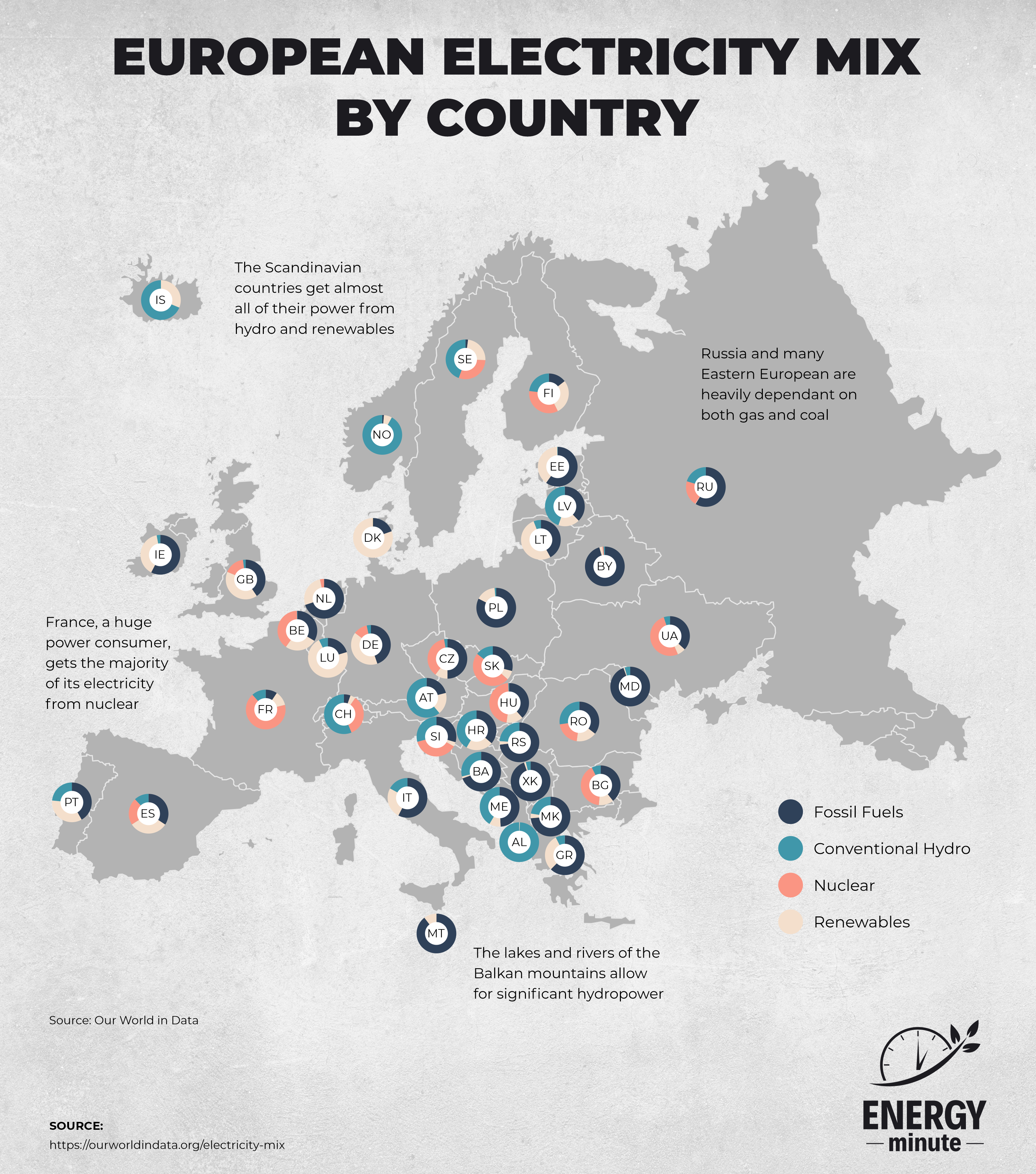European Electricity Mix by Country

Europe is a continent with a diverse mix of energy sources used to generate electricity. The differences in electricity sources across Europe are due to a combination of factors, including geography, political priorities, and access to natural resources.
Fossil fuels
Fossil fuels are the most commonly used source of electricity in Europe, accounting for around 43% of total electricity production. Coal, gas, and oil are the main types of fossil fuels used.
Germany, Poland, and the United Kingdom are the largest users of coal in Europe, with coal accounting for more than 20% of electricity production in each country. Gas is another popular source of electricity, particularly in countries such as the Netherlands, Italy, and Spain, which have access to significant reserves of natural gas.
Renewables
Renewable energy sources are becoming increasingly important across Europe, accounting for around 40% of total electricity production. The most significant renewable sources are wind, solar, and hydroelectric power.
Countries such as Denmark, Portugal, and Spain have been at the forefront of the renewable energy revolution, with wind power accounting for more than 40% of electricity production in Denmark and Portugal, and solar power accounting for more than 10% of electricity production in Spain.
Nuclear
Nuclear energy is another important source of electricity in Europe, accounting for around 14% of total electricity production.
France is the largest producer of nuclear energy in Europe, with nuclear power accounting for more than 70% of its electricity production. Other countries such as the Czech Republic, Slovakia, and Hungary also rely heavily on nuclear power.
2021 Electricity Mix by Country
| Fossil Fuels | Renewables | Nuclear | Conventional Hydro | |
| Albania | 0% | 1% | 0% | 99% |
| Austria | 21% | 18% | 0% | 61% |
| Belarus | 96% | 2% | 1% | 1% |
| Belgium | 34% | 26% | 40% | 0% |
| Bosnia and Herzegovina | 69% | 2% | 0% | 29% |
| Bulgaria | 39% | 12% | 41% | 7% |
| Croatia | 36% | 22% | 0% | 42% |
| Czechia | 50% | 10% | 37% | 3% |
| Denmark | 20% | 80% | 0% | 0% |
| Estonia | 60% | 40% | 0% | 0% |
| Finland | 15% | 28% | 34% | 23% |
| France | 9% | 12% | 67% | 12% |
| Germany | 45% | 40% | 11% | 3% |
| Greece | 62% | 30% | 0% | 7% |
| Hungary | 38% | 14% | 47% | 1% |
| Iceland | 0% | 31% | 0% | 69% |
| Ireland | 58% | 39% | 0% | 3% |
| Italy | 58% | 25% | 0% | 17% |
| Kosovo | 95% | 1% | 0% | 4% |
| Latvia | 38% | 18% | 0% | 45% |
| Lithuania | 42% | 52% | 0% | 6% |
| Luxembourg | 20% | 72% | 0% | 7% |
| Malta | 90% | 10% | 0% | 0% |
| Moldova | 94% | 1% | 0% | 5% |
| Montenegro | 49% | 9% | 0% | 41% |
| Netherlands | 70% | 27% | 3% | 0% |
| North Macedonia | 74% | 4% | 0% | 23% |
| Norway | 1% | 7% | 0% | 92% |
| Poland | 83% | 16% | 0% | 1% |
| Portugal | 42% | 35% | 0% | 24% |
| Romania | 36% | 17% | 21% | 27% |
| Russia | 59% | 0% | 21% | 20% |
| Serbia | 73% | 3% | 0% | 24% |
| Slovakia | 29% | 8% | 49% | 14% |
| Slovenia | 30% | 4% | 38% | 29% |
| Spain | 34% | 32% | 22% | 12% |
| Sweden | 2% | 24% | 30% | 44% |
| Switzerland | 5% | 4% | 34% | 56% |
| Ukraine | 37% | 7% | 51% | 5% |
| United Kingdom | 41% | 41% | 17% | 2% |
Geographical Differences
The geographical location of European countries plays a significant role in their choice of electricity sources.
- Countries located in the north of Europe, such as Denmark and Sweden, have abundant wind resources and have invested heavily in wind power.
- Countries in the south, such as Spain and Italy, have a sunny climate and have invested heavily in solar power.
- Countries with large rivers, such as Norway and Austria, have invested heavily in hydroelectric power. In contrast, countries without access to these resources have had to rely more heavily on fossil fuels and nuclear power.
Political Priorities
Political priorities also play a role in determining electricity sources across Europe. Some countries have prioritized reducing greenhouse gas emissions and have invested heavily in renewable energy sources. Germany, for example, has set ambitious targets for reducing greenhouse gas emissions and has invested heavily in wind and solar power. Other countries have prioritized energy security and have invested heavily in domestic sources of energy, such as nuclear power.
The differences in electricity sources across Europe are due to a combination of factors, including geography, political priorities, and access to natural resources. While fossil fuels remain the most commonly used source of electricity, renewable energy sources are becoming increasingly important. Countries that have invested heavily in renewable energy sources are likely to benefit from lower energy costs and reduced greenhouse gas emissions in the long term.
Source
https://ourworldindata.org/electricity-mix




